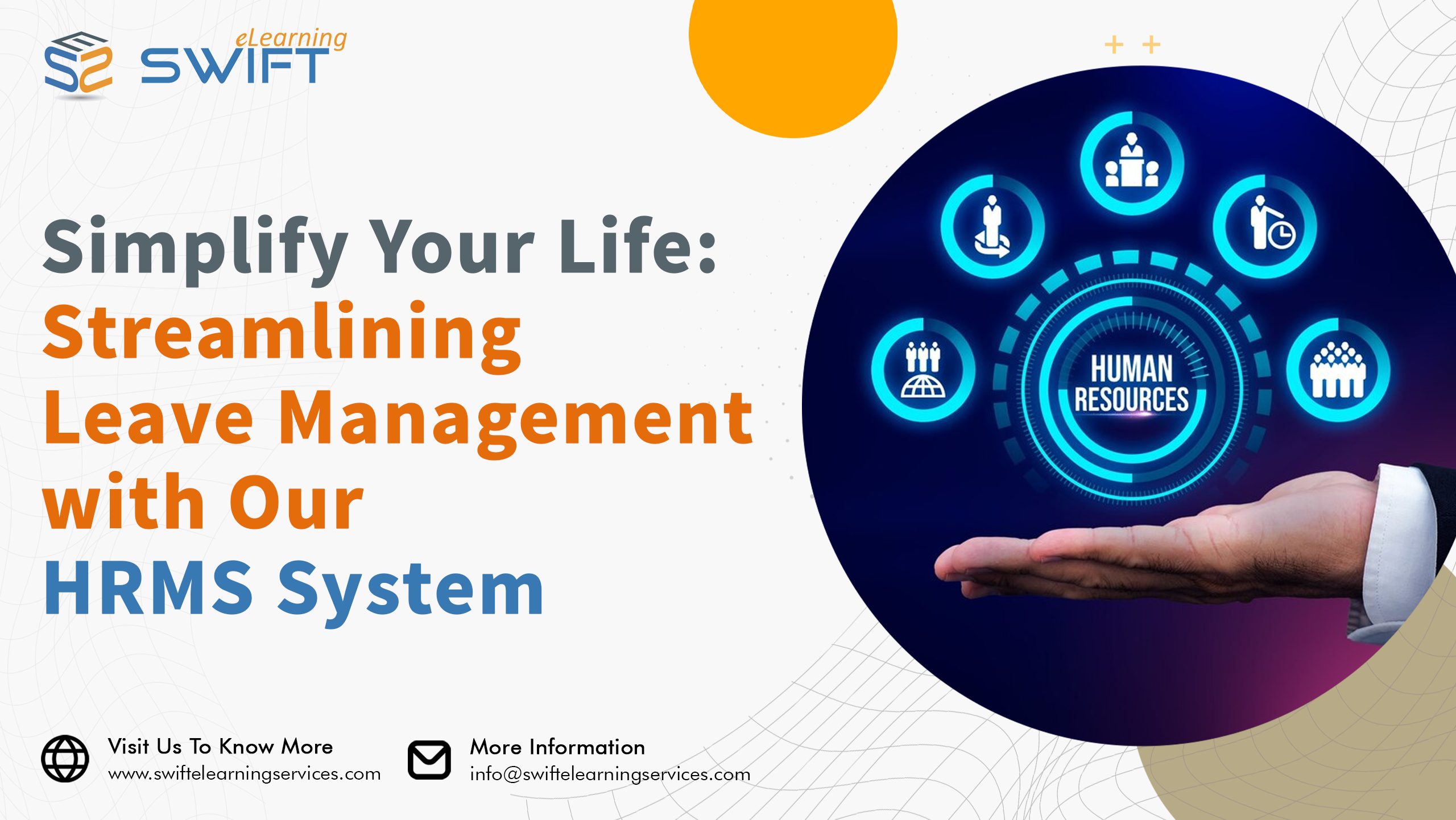Simplify Your Life: Streamlining Leave Management with Our HRMS System
In today’s fast-paced business world, efficiency and productivity are paramount. As organizations grow and evolve, managing employee leave can become a complex and time-consuming task.
Fortunately, modern technology has provided us with powerful tools to streamline this process. One such tool is the Human Resource Management System (HRMS), a comprehensive software solution that simplifies leave management and benefits both employers and employees.
In this blog post, we will explore how an HRMS system can revolutionize leave management, making it easier, more efficient, and ultimately, a boon for everyone involved.
1. The Complexity of Leave Management
Leave management has historically been a challenging aspect of HR for many organizations. It involves tracking various types of leave, such as vacation, sick days, personal days, and maternity/paternity leave, each with its own set of rules and regulations.
Additionally, managing leave requests, ensuring proper coverage during employee absences, and complying with labour laws can be daunting tasks.
Before the advent of HRMS systems, most organizations relied on manual methods, such as paper forms, spreadsheets, and emails, to handle leave requests and record-keeping. These methods were not only prone to errors but also time-consuming and inefficient. HR personnel often found themselves buried under a mountain of paperwork, leading to delays in processing requests and increasing the likelihood of errors.
2. The HRMS Solution
HRMS systems have revolutionized leave management by providing a centralized, automated platform that simplifies the entire process. Here are some key ways in which HRMS systems streamline leave management:
2.1 Self-Service Portals:
HRMS systems typically offer self-service portals for employees to submit leave requests. This allows employees to request time off conveniently, view their leave balances, and track the status of their requests in real-time. It reduces the administrative burden on HR staff and empowers employees to manage their own leave.
2.2 Automated Workflows:
HRMS systems automate the leave approval process. Once an employee submits a request, it can be routed through a predefined workflow for approval. This ensures that all leave requests are processed consistently and in compliance with company policies.
2.3 Accurate Leave Balances:
The system maintains accurate leave balances for each employee, taking into account accrual rates, carry-over rules, and other factors. This eliminates the risk of over granting or under granting leave and ensures that employees have a clear understanding of their available leave.
2.4 Real-Time Visibility:
HR and management have real-time visibility into leave data. This allows for better planning and resource allocation, as managers can see who is on leave at any given time and make informed decisions accordingly.
2.5 Compliance and Reporting:
HRMS systems often come with built-in compliance features that help organizations adhere to labor laws and company policies. They can generate reports on leave usage, helping HR track trends and make data-driven decisions.
2.6 Integration with Payroll:
Many HRMS systems seamlessly integrate with payroll software, ensuring that leave balances and deductions are accurately reflected in employees’ paychecks. This reduces payroll errors and ensures that employees are paid correctly during their time off.
3. Benefits for Employers
Implementing an HRMS system for leave management offers several benefits for employers:
3.1 Time and Cost Savings:
By automating leave management, HR personnel can save valuable time that would otherwise be spent on manual tasks. This leads to cost savings and allows HR staff to focus on more strategic initiatives.
3.2 Reduced Errors:
Automation reduces the risk of errors in leave calculations, ensuring that employees are granted the correct amount of leave and are paid accurately.
3.3 Improved Compliance:
HRMS systems help organizations stay compliant with labor laws and internal policies, reducing the risk of legal issues and penalties.
3.4 Enhanced Employee Satisfaction:
Streamlined leave management leads to faster approval processes and increased transparency. This, in turn, improves employee satisfaction and morale.
3.5 Better Resource Allocation:
Real-time visibility into leave data allows managers to make more informed decisions about resource allocation, ensuring that critical roles are adequately covered during employee absences.
4. Benefits for Employees
HRMS systems also benefit employees in several ways:
4.1 Convenience:
Self-service portals allow employees to request leave and check their leave balances from anywhere with an internet connection, providing convenience and flexibility.
4.2 Transparency:
Employees can track the status of their leave requests in real-time, reducing uncertainty and anxiety about whether their requests will be approved.
4.3 Accurate Leave Balances:
HRMS systems ensure that employees always have an accurate view of their leave balances, helping them plan their time off more effectively.
4.4 Faster Approvals:
Automated workflows typically result in faster leave approvals, allowing employees to make timely plans for their time off.
4.5 Fewer Disputes:
With accurate leave records and clear policies in place, there are fewer disputes between employees and HR regarding leave balances and usage.
5. Case Study: XYZ Corporation
Let’s take a look at a hypothetical case study to illustrate the impact of implementing an HRMS system for leave management.
XYZ Corporation, a mid-sized tech company, was struggling with leave management. Their manual processes led to frequent errors, delayed approvals, and frustrated employees. As the company continued to grow, the HR department found it increasingly challenging to keep up with the demands of leave management.
Recognizing the need for change, XYZ Corporation decided to implement an HRMS system. Here’s what happened:
5.1 Efficiency and Accuracy:
With the new system in place, leave requests were processed more efficiently, and errors were significantly reduced. This saved the HR department countless hours and eliminated the need for manual calculations.
5.2 Employee Satisfaction:
Employees at XYZ Corporation were delighted with the self-service portal, which allowed them to submit leave requests and check their balances with ease. The faster approval process also contributed to higher employee satisfaction.
5.3 Manager Visibility:
Managers had real-time visibility into leave data, enabling them to plan workloads more effectively and ensure that critical projects were adequately staffed.
5.4 Legal Compliance:
The HRMS system automatically tracked and applied labor laws and company policies, reducing the risk of non-compliance and potential legal issues.
5.5 Payroll Integration:
The integration with the company’s payroll system ensured that employees were paid accurately during their leave periods.
In summary, the implementation of an HRMS system revolutionized leave management at XYZ Corporation, resulting in a more efficient, error-free process that benefited both the HR department and employees.
6. Choosing the Right HRMS System
Selecting the right HRMS system for your organization is crucial to realizing the benefits of streamlined leave management. Here are some factors to consider:
6.1 User-Friendly Interface:
Ensure that the HRMS system has a user-friendly interface that will be easy for both HR staff and employees to navigate.
6.2 Customization:
Look for a system that allows you to customize leave policies and workflows to match your organization’s unique requirements.
6.3 Integration Capabilities:
Check whether the HRMS system can integrate seamlessly with other software solutions your organization uses, such as payroll, time and attendance, and accounting software.
6.4 Scalability:
Choose a system that can grow with your organization and accommodate increasing numbers of employees and leave requests.
6.5 Vendor Support:
Assess the level of support and training provided by the HRMS vendor to ensure a smooth implementation and ongoing use of the system.
Conclusion
Leave management is a critical function of HR that can greatly benefit from the implementation of an HRMS system. The automation, accuracy, and efficiency that these systems bring to leave management not only save time and resources but also improve employee satisfaction and ensure legal compliance.
If your organization is still grappling with manual leave management processes, it’s time to consider simplifying your life and streamlining leave management with the power of an HRMS system. By doing so, you’ll unlock a world of benefits for both your HR department and your valued employees. Embrace the future of HR, and make leave management a breeze with the right HRMS solution.
Frequently Asked Questions (FAQs)
What is an HRMS system, and how does it simplify leave management?
An HRMS (Human Resource Management System) is a software solution that automates various HR processes, including leave management. It simplifies leave management by offering self-service portals for employees to request time off, automating approval workflows, maintaining accurate leave balances, and ensuring compliance with labour laws and company policies.
How can an HRMS system benefit employers?
Employers can benefit from an HRMS system in several ways, including time and cost savings, reduced errors, improved compliance, enhanced employee satisfaction, and better resource allocation.
What advantages do employees gain from an HRMS system for leave management?
Employees benefit from an HRMS system through increased convenience, transparency in leave balances and requests, faster approvals, and reduced disputes over leave usage and balances.
Can you provide a real-life example of how an HRMS system transformed leave management?
Certainly. In our case study of XYZ Corporation, the implementation of an HRMS system resulted in increased efficiency, reduced errors, higher employee satisfaction, better manager visibility, improved legal compliance, and seamless payroll integration. It’s a tangible example of how an HRMS system can revolutionize leave management.
What factors should we consider when choosing the right HRMS system for our organization?
When selecting an HRMS system, it’s essential to consider factors such as user-friendliness, customization options, integration capabilities, scalability, and the level of support and training provided by the vendor. These factors will ensure that the chosen system aligns with your organization’s unique needs and goals.
How can we get started with implementing an HRMS system for leave management?
To get started with implementing an HRMS system for leave management, you should first research and select a reputable HRMS vendor that suits your requirements. Then, work closely with the vendor to plan the implementation process, including customization, training, and integration with other systems. A successful implementation will set you on the path to simplified leave management.











Leave a Reply
Want to join the discussion?Feel free to contribute!